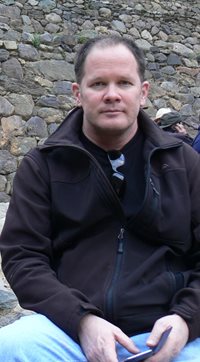“'ASTMH in Peru' brings motivation and promotes excellence in tropical medicine research." -
Miguel M. Cabada, MD, MSc
Miguel obtained his medical degree from Universidad Peruana Cayetano Heredia (UPCH) in Lima, Peru, and did a five-year post-doc in tropical and travel medicine under the mentorship of Eduardo Gotuzzo, MD, FACP, FIDSA, at the UPCH Tropical Medicine Institute. Dr. Cabada trained as a clinician and researcher in infectious diseases under A. Clinton White, Jr., MD, at The University of Texas Medical Branch at Galveston (UTMB). He serves as a Councilor for the ASTMH ACCTMTH (Clinical Group), faculty at UTMB’s infectious diseases division and director of the UPCH-UTMB Research Center in Cusco, Peru. He splits his time between clinical duties and research in tropical and travel medicine in Peru. Dr. Cabada is also PI for a NIAID-sponsored epidemiologic study on the impact of fascioliasis in the highlands of Cusco. His main clinical and research interests are neglected tropical parasites, including Fasciola hepatica
, soil-transmitted helminths and cestode infections.
 Why did you choose to continue your work in Cusco and what is most rewarding about what you do there?
Why did you choose to continue your work in Cusco and what is most rewarding about what you do there?
As a post-doc in Cusco, a significant part of my time was devoted to research in tropical and travel-related illnesses. However, the research capacity in the region was scarce and many of the prevalent tropical diseases (e.g., fascioliasis and cystic echinococcosis) were completely neglected. The interest for research and tropical and travel medicine lingered in my mind after leaving Cusco and ultimately brought me back six years later after finishing my training. The idea was to create capacity in the region to train and do research in global health. With support from The University of Texas Medical Branch, Universidad Peruana Cayetano Heredia and collaborators in the U.S. Naval Medical Research Unit 6, we started a research center in Cusco a few years ago. Through our activities we are increasing awareness about neglected tropical diseases among local populations, training local healthcare personnel to do research and providing experiences in global health research to American trainees. In addition, we are bringing diagnostics and treatment for neglected tropical parasites to thousands of local people.
You are a Councilor for the Clinical Group. What motivated you to take the next step from being a Society member to a member and leader of a subgroup?
The Clinical Group is attractive for the expertise of its members and the shared interests for clinical tropical medicine and traveler’s health. Serving as a Councilor in the Clinical Group is a way of becoming actively involved with the Society and contributing time and effort to advance the tropical and travel medicine fields. It is also a great opportunity to learn from other Society members with years of experience in leadership positions.
More than 225 attendees from 14 countries in the Americas and Europe attended the 6th annual “ASTMH in Peru.” What value do you think the Society brings to the South American tropical medicine community?
Institutions in the Americas are fostering a critical mass of young investigators and leaders in tropical medicine. Many groups in Latin America, including Peru, are producing important research in this field. The ASTMH Annual Conference is the prime venue to present the results of these studies. However, some barriers may prevent research team members from traveling to attend ASTMH. Holding the meeting in Lima opens the opportunity for local professionals to learn about and get inspired by the research conducted by their colleagues in Peru. "ASTMH in Peru" brings motivation and promotes excellence in tropical medicine research.
Now for our final question – we ask it of everyone: You get the opportunity to go back in time. You can either have a conversation with any scientist who has ever lived OR observe a moment of scientific history. What would you choose and why?
Watching epidemiology in action throughout the history of medicine has always been fascinating to me. From John Snow and the cholera outbreak in London to William C. Gorgas and yellow fever control to the work of Carrion in the description of the Oroya fever (Bartonellosis). All those were brilliant minds working to solve big medical issue and events that I would choose to witness.